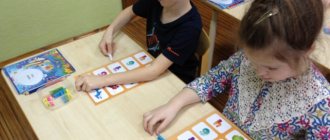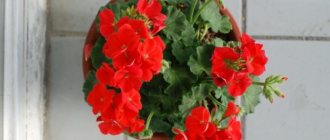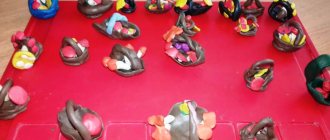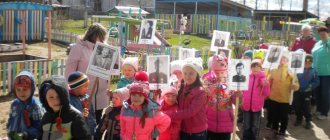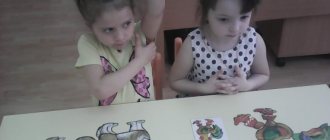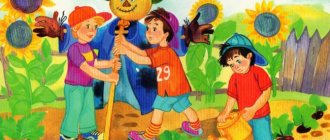Story pictures on speech development
In this section you can download ready-made sets of plot pictures for composing stories. Each set includes two or three pictures connected by a common plot or cause-and-effect relationships. Learning to compose stories based on one picture or a series of plot pictures promotes the development of coherent speech in children of preschool and primary school age. Looking at pictures develops a child's attention. By composing a story from pictures, the child develops thinking when he tries to understand their content, cause-and-effect, spatio-temporal, logical connections between the events depicted on them.
Download and print the assignment form. Cut it with scissors along the dotted lines. Ask your child to arrange the pictures into several sets, as logic dictates. After this, the child must determine the correct sequence of pictures for each set and compose a story based on them. But don’t rush to correct your child if, in your opinion, he has arranged the pictures incorrectly. Listen to his story first, maybe his logic will seem quite convincing to you. You should be alert if: 1. the child could not detect any connection between the pictures; 2. the child was often distracted from the topic of the story, did not highlight the “main” events, or there were many repetitions in the story; 3. the child only listed the objects in the pictures, used separate, short (non-extended) sentences; 4. The meanings of words were approximate; the child rarely used adjectives, adverbs, or words of a general nature.
ATTENTION!
All cards are prepared in pdf format. Typically, most computers already have the free Adobe Reader installed, which you can use to open and print the cards. If for some reason you do not have this program, please visit the ADOBE website here
Form 1
Download and print the assignment form. The form shows two pictures, for each of them the child must come up with and tell a short story.
Form 2
Download and print the assignment form. Cut it with scissors along the dotted lines. Ask your child to arrange the resulting cards into three sets (two cards in each set), as logic dictates. If a child makes a mistake, do not rush to correct him immediately, first listen to his version. After this, the child must determine the correct sequence of cards for each set and write a short story based on them.
Form 3
Download and print the assignment form. Cut it with scissors along the dotted lines. Ask your child to arrange the resulting cards into three sets (two cards in each set), as logic dictates. If a child makes a mistake, do not rush to correct him immediately, first listen to his version. After this, the child must determine the correct sequence of cards for each set and write a short story based on them.
Form 4
Download and print the assignment form. Cut it with scissors along the dotted lines. Ask your child to arrange the resulting cards into three sets (two cards in each set), as logic dictates. If a child makes a mistake, do not rush to correct him immediately, first listen to his version. After this, the child must determine the correct sequence of cards for each set and write a short story based on them.
Form 5
Download and print the assignment form. Cut it with scissors along the dotted lines. Ask your child to arrange the resulting cards into three sets (two cards in each set), as logic dictates. If a child makes a mistake, do not rush to correct him immediately, first listen to his version. After this, the child must determine the correct sequence of cards for each set and write a short story based on them.
Form 6
Download and print the assignment form. Cut it with scissors along the dotted lines. Ask your child to arrange the resulting cards into two sets (three cards in each set), as logic dictates. If a child makes a mistake, do not rush to correct him immediately, first listen to his version. After this, the child must determine the correct sequence of cards for each set and write a short story based on them.
Form 7
Download and print the assignment form. Cut it with scissors along the dotted lines. Ask your child to arrange the resulting cards into two sets (three cards in each set), as logic dictates. If a child makes a mistake, do not rush to correct him immediately, first listen to his version. After this, the child must determine the correct sequence of cards for each set and write a short story based on them.
Form 8
Download and print the assignment form. Cut it with scissors along the dotted lines. Ask your child to arrange the resulting cards into two sets (three cards in each set), as logic dictates. If a child makes a mistake, do not rush to correct him immediately, first listen to his version. After this, the child must determine the correct sequence of cards for each set and write a short story based on them.
Form 9
Download and print the assignment form. Cut it with scissors along the dotted lines. Ask your child to arrange the resulting cards into two sets (three cards in each set), as logic dictates. If a child makes a mistake, do not rush to correct him immediately, first listen to his version. After this, the child must determine the correct sequence of cards for each set and write a short story based on them.
Form 10
Download and print the assignment form. Cut it with scissors along the dotted lines. A series of pictures to establish spatial relationships between objects. To develop the ability to determine the position of an object in relation to another object. Pictures for the following spatial relationships: on, under, behind, in front, on the right, on the left.
Form 11
Download and print the assignment form. Cut it with scissors along the dotted lines. A series of pictures to establish spatial relationships between objects. To develop the ability to determine the position of an object in relation to another object. Pictures for the following spatial relationships: next to, in, behind, between, in front of, on.
How can they be used?
One of them, already mentioned, is pictures for making a short story. On our website you will find story pictures for children. It is extremely important that the images are subordinated to a single theme, which means that the child, looking at them, will be able to compose a coherent message or play role-playing games for preschoolers. It is not for nothing that when teaching a foreign language, students are asked to describe a picture, come up with a dialogue according to the presented situation, and create role-playing games. This technique is also applicable when teaching the native language in a kindergarten or aesthetic center. You can download illustrations for writing a short story and print them for work.
The technique for developing speech based on pictures for composing a short story is simple. We advise parents to play role-playing games with their baby, lay out illustrations in front of him, and come up with a story together, a story in which the baby’s family or friends will be involved. Make sure that when describing, the child does not jump from one action or object to another, but expresses his thoughts consistently and logically. Having conducted such a lesson once, return to the worked picture after a while: ask the child if he remembers the story he compiled, what details he did not take into account, what he could add. A series of plot pictures for composing a short story are good for lessons on speech development in primary school, in native or foreign language lessons. Descriptions of illustrations, role-playing games, and a story based on them can be a good basis for creative work. Usually children respond with pleasure to such tasks, since children's imagination has not yet taken root, its flight is free and unhindered.
The method of working with pictures for children will require attention and regular practice from parents. It is the family that should be interested in the development of the baby. They should help him create a story, role-playing games for preschoolers, and then discuss them together.
A series of pictures for kindergarten or home use for children are focused on different topics. For example, you can compose a story on the topic “Family”, “Seasons”, “Forest”, “Home”, etc. The methodology for developing speech for children involves comprehensive coverage of topics on which a story can be compiled. The technique also involves the use of games for kindergarten, which will contain illustrations or a story on the chosen topic. As a result of a series of such activities, children begin to speak much more coherently, logically, and a single thread can be traced in their speech.
home
Municipal budgetary preschool educational institution No. 107, Lipetsk
| Address: Lipetsk, st. 8 March, 20/3 st. Tolstogo, 46a Phones: 77 54 98, 25 08 18, 25 01 22 Head: Soboleva Irina Vadimovna |
Municipal budgetary preschool educational institution No. 107 in Lipetsk has been operating since 1978.
Based on the order of the Department of Education of the Lipetsk city administration dated October 24, 2017 No. 1491, preschool educational institution No. 107 in Lipetsk was reorganized by merging with it preschool educational institution No. 48 in Lipetsk.
Head: Soboleva Irina Vadimovna.
State registration number of the entry on the creation of a legal entity: 1024840826152, registration certificate series 48 No. 001429397 issued by the Inspectorate of the Federal Tax Service of Russia for the Sovetsky District of Lipetsk on November 09, 1999.
Educational activities are carried out in accordance with the license for the right to conduct educational activities: series RO registration No. 1719 dated 02/13/2018
Legal address: Lipetsk city, st. 8 March, 20/3
st. Tolstogo, 46a
Passenger transport routes: 2,12, 302, 27, 30, 330, 352, 328, 315
Opening hours: from 7.00 to 19.00 daily, except weekends and holidays.
Phone numbers for inquiries: 77 54 98, 25 08 18, 25 01 22.
Email address:,
Website address:
Structure of the educational institution:
In the 2021-2022 academic year, 17 preschool groups operate in the preschool educational institution, including:
- first junior group (from 2 to 3 years old) - 2;
- second younger group (from 3 to 4 years old) - 1;
- middle group (from 4 to 5 years) - 2;
- senior group (from 5 to 6 years old) - 2;
- preparatory group (from 6 to 7 years old) - 2;
- speech therapy group (from 5 to 7 years) - 3;
- group of children with visual impairments - 2;
- group for children with mental retardation – 2;
- group for children with mental retardation (Down syndrome) - 1.
The educational activities of the institution are carried out in accordance with the Basic General Educational Program of Preschool Education of Preschool Educational Institution No. 107.
The preschool educational institution interacts with MBOU gymnasium No. 1 on issues of continuity of education.
The preschool institution is located in a single educational space with the Lipetsk State Pedagogical University named after P.P. Semenov-Tyan-Shansky, Regional Children's Library, Special Library for the Blind.
The preschool educational institution has access to the INTERNET network, provider "Center Telecom"
Founder: Department of Education of the Lipetsk City Administration
Founder's address: 398032, Lipetsk, Kosmonavtov Street, 56 a. Founder's email Website address: https://www.doal.ru/ Tel. 309-601 Fax: (4742)34-99-09
Chairman Bedrova Svetlana Valerievna
Reception days: the first and third Tuesday of the month from 14-00 to 17-30 in the Department of Education of the Lipetsk City Administration The Department of Education of the Lipetsk City Administration is a structural unit of the Lipetsk City Administration with the rights of a legal entity.


